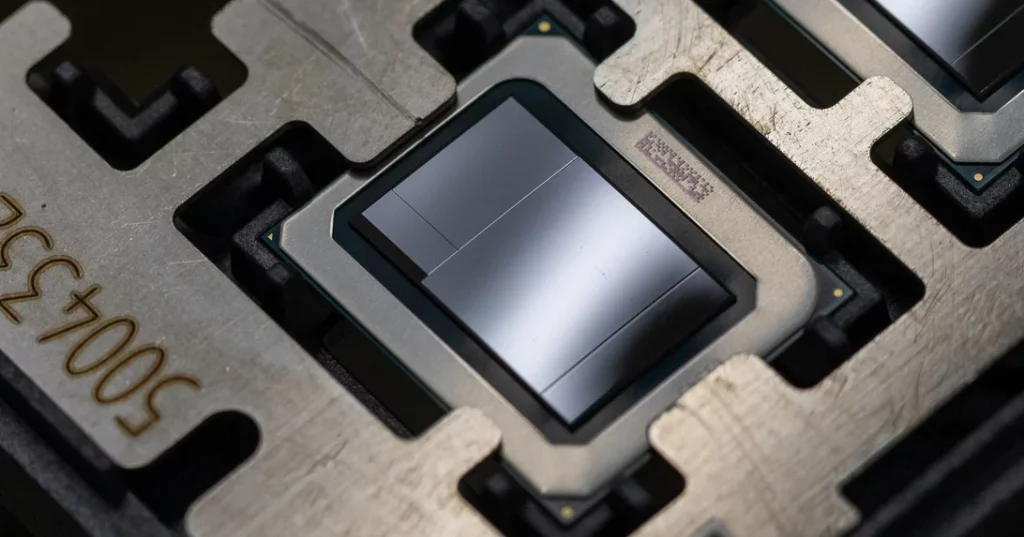[ad_1]
Intel’s Meteor Lake CPUs have received new support within the IGC (Intel Graphics Compiler) to enable the Xe-HPG (Arc Alchemist) TGPUs which are featured on the upcoming chips.
Intel’s Arc Alchemist ‘Xe-HPG’ Integrated GPUs on Next-Gen Meteor Lake CPUs Get Preliminary Support
The latest commit for Intel’s Meteor Lake CPUs was added by Pete Chou for the IGC (Intel Graphics Compiler). The main focus of this new commit is to enable support for the 14th Gen Meteor Lake CPUs and the integrated GPUs featured within it. The Intel Meteor lake CPUs will be the first to get the same graphics architecture that’s featured on the desktop and mobile lineup. The specific tGPU (Tiled-GPU) featured on the Meteor Lake CPUs is listed as “Xe_MTL”.

With the new commit, an interesting thing that was pointed out by Coelacanth Dream is that the Intel Meteor Lake CPUs do not feature DPAS instructions and as such, don’t carry XMX units. The DPAS (Dot Product Accumulate Systolic) instructions are used to perform matrix multiplication-accumulate operations. The missing DPAS instructions may indicate that the Meteor Lake TGPUs might be lacking the XMX unit which mainly aims to provide higher inferencing and AI speeds. It’s crucial for the new XeSS (Ai-Assisted) technology which will is an AI-upscale similar to the NVIDIA DLSS technology.
Instead of the DPAS (XMX) units, the Intel Meteor Lake CPUs will feature a VPU (Vision Processing Unit) which may provide some form of inferencing prowess that may help with XeSS but if so, the processing would be handled off the primary GPU chip. Additionally, there’s also partial support for FP64 (dual-precision) compute on Meteor Lake’s Tiled-GPUs that has been listed within the commit. Intel removed FP64 & Int64 support from its Gen 11 architecture but it seems to be coming back next year with Meteor Lake chips.

The Meteor Lake CPUs will be utilizing a tiled Arc graphics-powered GPU which will make it an entirely new class of graphics on a chip. It’s neither an iGPU nor a dGPU & currently regarded as tGPU (Tiled GPU / Next-Gen Graphics Engine). The Meteor Lake CPUs will utilize the brand new Xe-HPG graphics architecture, allowing for increased performance at the same level of power efficiency as existing integrated GPUs. This will also enable enhanced support for DirectX 12 Ultimate and XeSS, features that are only supported by the Alchemist lineup as of right now.
Intel Mainstream Desktop CPU Generations Comparison:
| Intel CPU Family | Processor Process | Processors Cores/Threads (Max) | TDPs | Platform Chipset | Platform | Memory Support | PCIe Support | Launch |
|---|---|---|---|---|---|---|---|---|
| Sandy Bridge (2nd Gen) | 32nm | 4/8 | 35-95W | 6-Series | LGA 1155 | DDR3 | PCIe Gen 2.0 | 2011 |
| Ivy Bridge (3rd Gen) | 22nm | 4/8 | 35-77W | 7-Series | LGA 1155 | DDR3 | PCIe Gen 3.0 | 2012 |
| Haswell (4th Gen) | 22nm | 4/8 | 35-84W | 8-Series | LGA 1150 | DDR3 | PCIe Gen 3.0 | 2013-2014 |
| Broadwell (5th Gen) | 14nm | 4/8 | 65-65W | 9-Series | LGA 1150 | DDR3 | PCIe Gen 3.0 | 2015 |
| Skylake (6th Gen) | 14nm | 4/8 | 35-91W | 100-Series | LGA 1151 | DDR4 | PCIe Gen 3.0 | 2015 |
| Kaby Lake (7th Gen) | 14nm | 4/8 | 35-91W | 200-Series | LGA 1151 | DDR4 | PCIe Gen 3.0 | 2017 |
| Coffee Lake (8th Gen) | 14nm | 6/12 | 35-95W | 300-Series | LGA 1151 | DDR4 | PCIe Gen 3.0 | 2017 |
| Coffee Lake (9th Gen) | 14nm | 8/16 | 35-95W | 300-Series | LGA 1151 | DDR4 | PCIe Gen 3.0 | 2018 |
| Comet Lake (10th Gen) | 14nm | 10/20 | 35-125W | 400-Series | LGA 1200 | DDR4 | PCIe Gen 3.0 | 2020 |
| Rocket Lake (11th Gen) | 14nm | 8/16 | 35-125W | 500-Series | LGA 1200 | DDR4 | PCIe Gen 4.0 | 2021 |
| Alder Lake (12th Gen) | Intel 7 | 16/24 | 35-125W | 600 Series | LGA 1700/1800 | DDR5 / DDR4 | PCIe Gen 5.0 | 2021 |
| Raptor Lake (13th Gen) | Intel 7 | 24/32 | 35-125W | 700-Series | LGA 1700/1800 | DDR5 / DDR4 | PCIe Gen 5.0 | 2022 |
| Meteor Lake (14th Gen) | Intel 4 | TBA | 35-125W | 800 Series? | LGA 1851 | DDR5 | PCIe Gen 5.0 | 2023 |
| Arrow Lake (15th Gen) | Intel 20A | 40/48 | TBA | 900-Series? | LGA 1851 | DDR5 | PCIe Gen 5.0 | 2024 |
| Lunar Lake (16th Gen) | Intel 18A | TBA | TBA | 1000-Series? | TBA | DDR5 | PCIe Gen 5.0? | 2025 |
| Nova Lake (17th Gen) | Intel 18A | TBA | TBA | 2000-Series? | TBA | DDR5? | PCIe Gen 6.0? | 2026 |
[ad_2]
Source link
